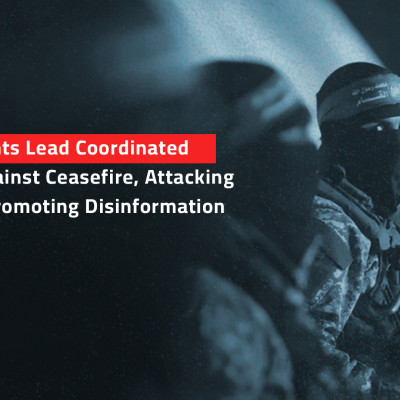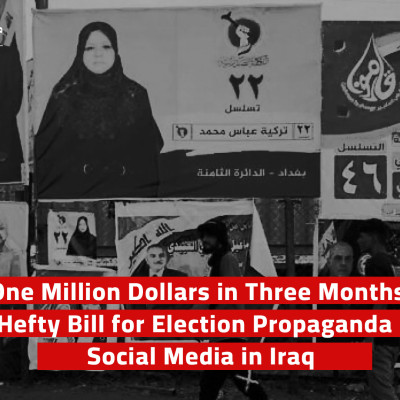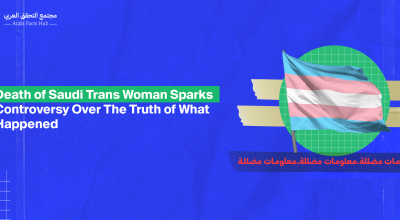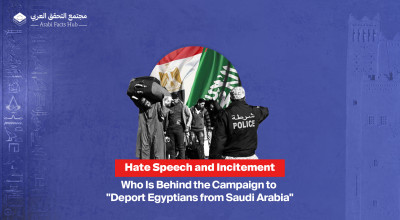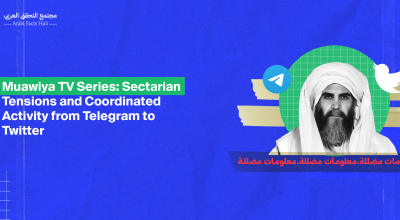Supporters of Assad and Hezbollah... Coordinated campaign to exploit the earthquake disaster and accuse the Caesar Act

This is part of a series of investigative reports published in collaboration with Daraj media
Accounts affiliated with the Syrian government and Lebanese Hezbollah have launched campaigns to justify the failure of President Bashar Al Assad's regime to carry out relief and rescue operations. The campaigns used various hashtags and names but ultimately focused on blaming the "Caesar Syria Civilian Protection Act," also known as the "Caesar Act" imposed by the United States.
_____________________________________________________________________________
Approximately 24 hours after the devastating earthquake on February 6th in Syria and Turkey, which claimed the lives of more than 50,000 people, coordinated political campaigns emerged, trying to capitalize on the humanitarian solidarity with the earthquake victims for their own political agendas. Accounts affiliated with the Syrian government and Lebanese Hezbollah launched campaigns to justify the failure of President Bashar Al Assad's regime to carry out relief and rescue operations. The campaigns used various hashtags and names but ultimately focused on blaming the "Caesar Syria Civilian Protection Act," also known as the "Caesar Act," imposed by the United States. The Act, which came into effect in June 2020, aimed to push Assad towards agreeing to a political solution to the Syrian crisis without remaining in power.
Four days after the earthquake, President Assad visited the affected areas. Standing amidst the rubble in the city of Aleppo, northwest of the country, the President was smiling while addressing the press. Many Syrians deemed this inappropriate in the context of the catastrophe, and a wave of dissatisfaction followed.
UN officials held a series of direct meetings with Assad in the capital, Damascus, urging him to agree to open more border crossings with Turkey to allow aid to enter the affected areas in northwest Syria, which are largely under opposition control. Eventually, his approval was announced days after the earthquake.
Meanwhile, Syrian and Lebanese campaigns supporting Assad were amplifying the demand to lift the siege and sanctions on Syria, claiming it was a necessary measure to facilitate obtaining aid and carrying out rescue operations. Ironically, one of the conditions for lifting the Caesar Act is that the Syrian regime and its Russian and Iranian allies lift restrictions on the access of humanitarian assistance to besieged areas, cities, and villages, and allow civilians freedom of movement. The hashtag #Caesar_obstructs_rescue was one of the most active hashtags, with a total of 11,301 tweets, including 1,327 original tweets and 9,348 in the form of retweets. Additionally, it received 41,498 likes during the period from February 7 to February 23.
The hashtag peaked on February 7, with 410 tweets that garnered 4,430 retweets, contributing to the trend's popularity and spread. According to Get Day Trends, Lebanon was one of the countries where the hashtag gained significant traction, reaching the third position in the list of the most trending topics and achieving this on February 8.
Who mobilizes the hashtag?
631 accounts participated in activating the hashtag. The most prominent of them were accounts for individuals and media outlets close to Hezbollah, and some Yemeni accounts associated with the Houthis.

Illustration showing the most active accounts in the hashtag #Caesar_obstructs_rescue – Gephi
The content of the handle @mm73630mm, which tweeted the most, indicates an ideological affiliation with the Houthis, who are supported by Iran. Similarly, Yemeni tweep @abojrhom identifies themselves as a social influencer. Another tweep, @batoul_76, identifies as a Yemeni girl living in southern Lebanon, where the influence of Hezbollah is prominent.
The handle @RetweetMalek, second only to @mm73630mm in the number of tweets, is part of a retweet network. Its interactions take the form of retweets from various accounts that share an interest in the situation in Yemen, Iraq, Syria, and Lebanon, particularly from the perspective of Iran-backed forces.
AlAhed News Website’s English language handle, @English_AlAhed, stood out due to its repeated use of the hashtag.
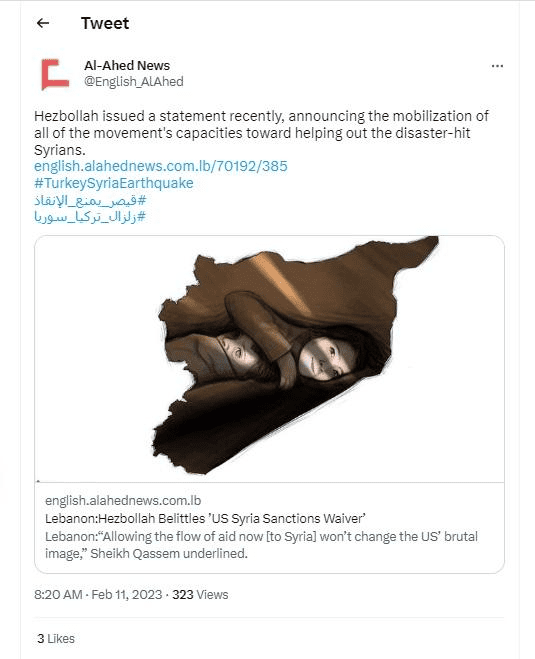
The news site AlAhed first appeared on the Internet with its current extension alahednews.com.lb in September 2014. It is registered under the name of Ibrahim Ezzeddine.
بيانات تسجيل موقع العهد الإخباري
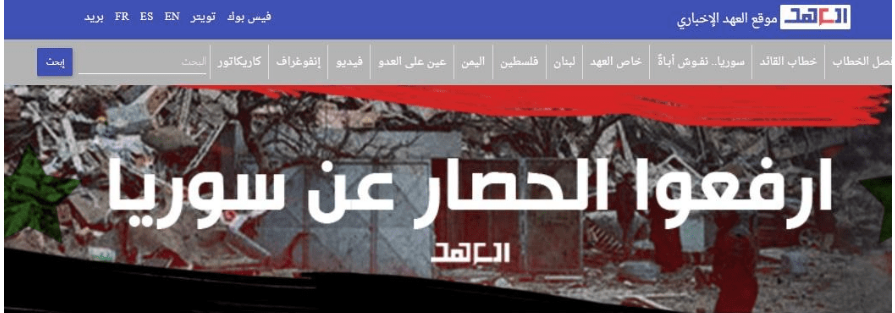
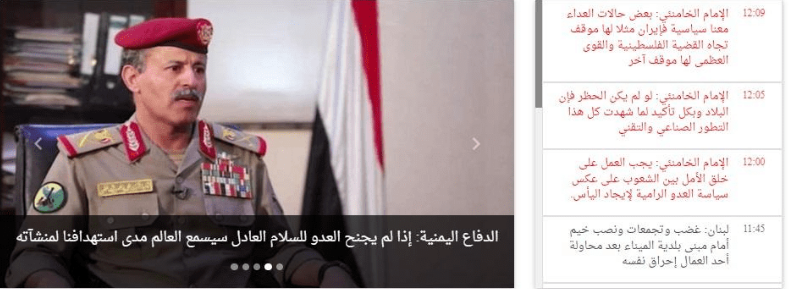
The website, which focuses on covering coalitions associated with Iran, appears to be part of a network of Lebanese and Iranian websites. The network also includes Dar Al Manar (part of the Hezbollah-affiliated Al Manar Network), and the website of the Iranian channel Al Sirat (which was seized by U.S. authorities, according to data analysis from the Al Ahed website).
There were also tweets from an account using the name of the semi-official Iranian news agency, Tasnim. The account does not seem professional, but it regularly posts news from Tasnim. It used the hashtag in its tweets, some of which were not necessarily related to the hashtag's topic, and some related to Iranian affairs.
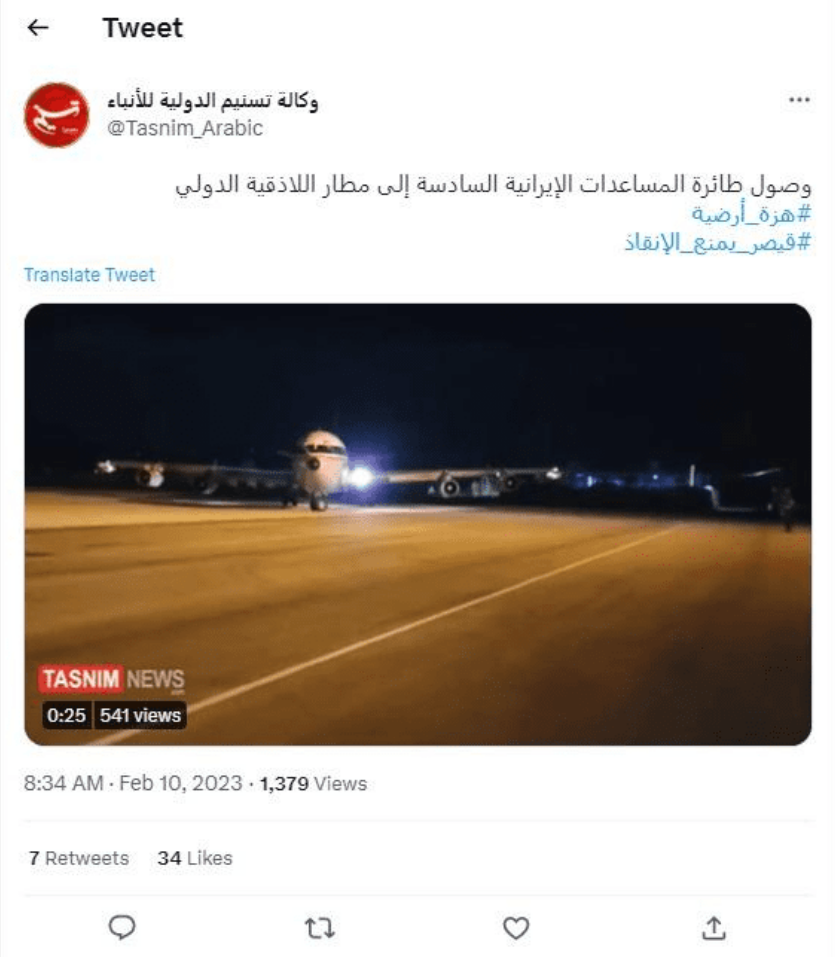
It is noteworthy that accounts and pages closely aligned with Hezbollah launched the hashtag #Caesar_obstructs_rescue. Tweets from these accounts reflected a coordinated effort to mobilize and amplify the hashtag. This was observed, for example, through the accounts of"Al Multaqa Al Muqawim (@2e3lammk2020) and Nasseem Center (@nasseembek), based in the southern Bekaa region of Lebanon. In a tweet, the Al Multaqa Al Muqawim account specified 7:30 PM as the time to activate the hashtag on social media. This aligns closely with what was shown on the heat map of the InVID tool regarding the most active hours for the hashtag, starting from 7:00 PM on the same day (February 7th).
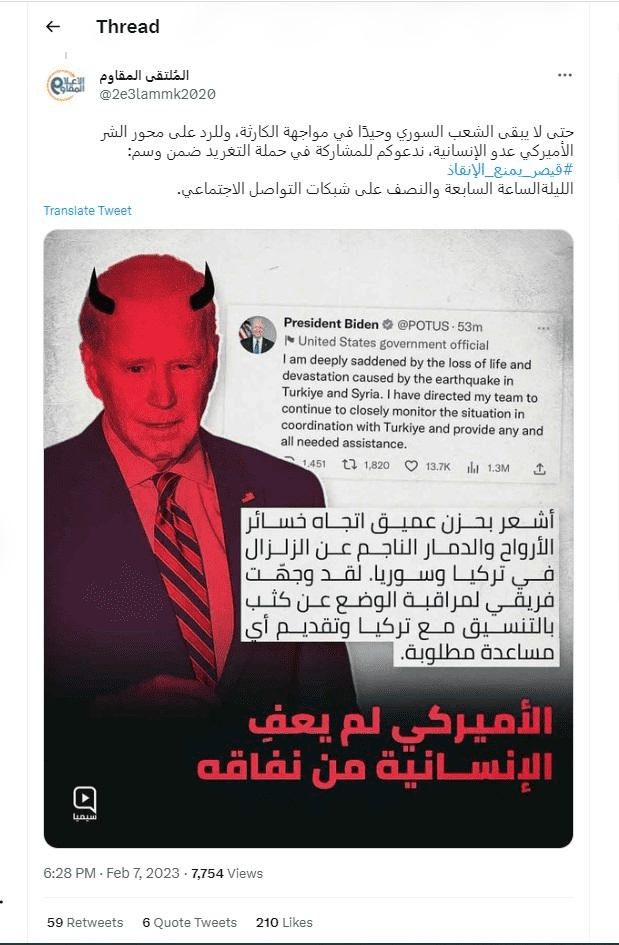
Both accounts were part of a mobilization machine for hashtags and campaigns. One example is the campaign that attacked and tarnished the reputation of Tarek Bitar, the judge investigating the Beirut port explosion. Bitar caused a significant stir when he unexpectedly announced in January of last year the resumption of investigations after they had been halted. At that time, the trending hashtag against him was #Bitar_is_managed_from_abroad, and Al Multaqa Al Muqawim and other supporters of Hezbollah played a role in propagating it.
Twitter had previously suspended the account of the Nasseem Center for some time, as announced by the account itself. The account redirects its followers to the backup account, @nasseembek1. This suspension is likely a result of the account's excessively high tweet activity exceeding normal tweeting rates.
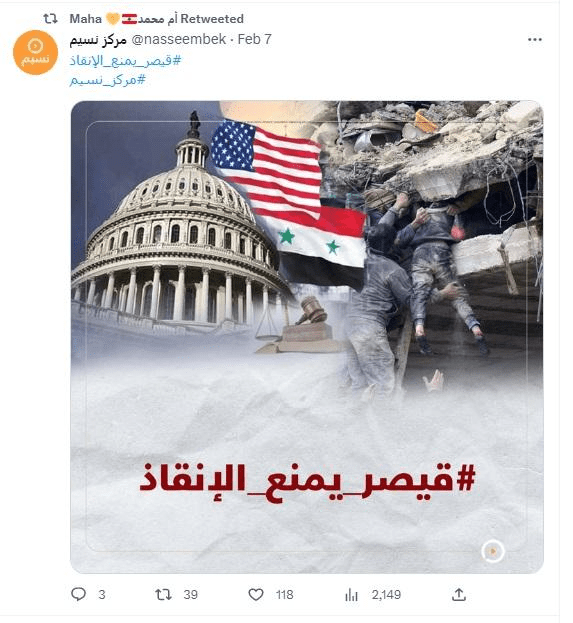
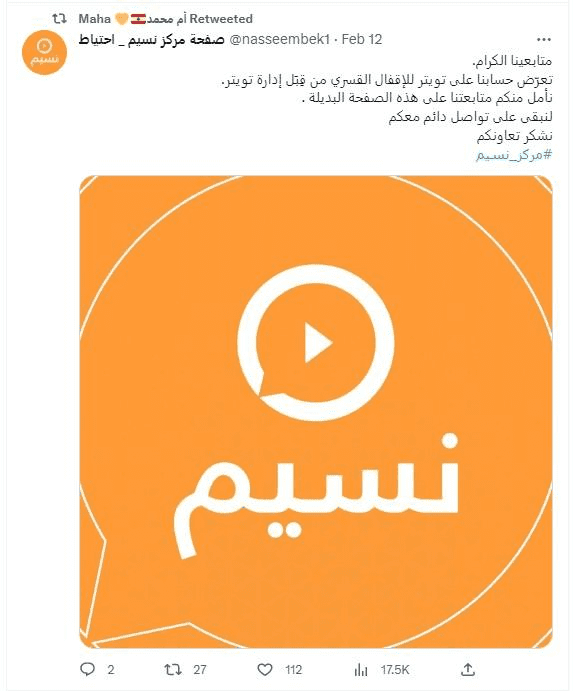
Initiator of the #Lift_the_siege hashtag took a picture with Bashar Al Assad
In addition to the previous hashtag, #lift_the_seige_on_Syria gained prominence during the surge of interest in the developments of the earthquake in the country. Between February 1st and 23rd, the hashtag was used in 32,410 tweets, including 6,999 original tweets, and 139,319 likes.
The hashtag appeared to be significantly coordinated. Later, Amar Al Berry, a young Syrian journalist who is primarily interested in covering entertainment news, said that he launched the campaign after reaching out to influencers and public figures and asking them to use it. In a statement to Arabic media outlets, he said that he contacted these individuals "to make the hashtag trend on Twitter."
Al Berry studied at the University of Damascus before moving to work in Lebanon. He has connections with celebrities in Lebanon and Syria, as evident from his posts on social media. In his tweets on social networks, he called for setting aside differences and working on delivering aid to all earthquake-affected areas. Towards the end of last year, he appeared in a group photo with the Syrian President Bashar Al Assad at the Presidential Palace in Damascus, during an event that was organized by the National Union of Syrian Students.
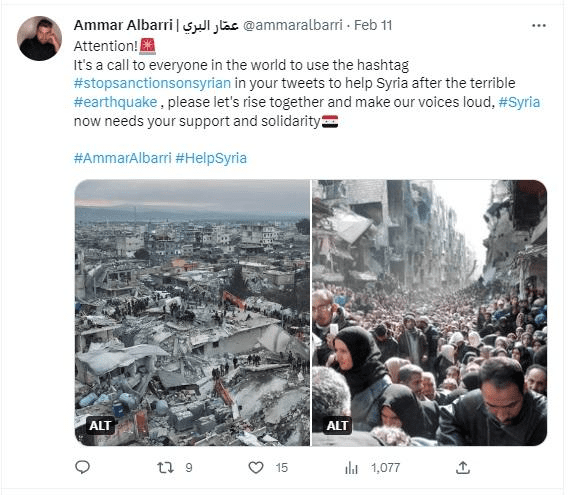
From the foregoing, it is evident that the earthquake that struck Syria presented an opportunity for the regime and its supporters to pursue their political interests. Social media saw attempts to amplify hashtags supportive of the regime. Hezbollah supporters played a central role in these efforts, with media outlets associated with Hezbollah and Iran in tweeting using these hashtags.
The high rates of tweeting prompted Twitter management to suspend some accounts. What further prompted the suspension is that these tweets were significantly coordinated, as evidenced by the timing of hashtag launches, where a specific date and time were set for inviting participation.
Those behind these hashtags sought to amplify them to advance on trending lists or become the most circulated. It is noteworthy that some coordinators of hashtag activation took part in earlier campaigns, such as the campaign attacking the investigative judge in the Beirut port explosion.



